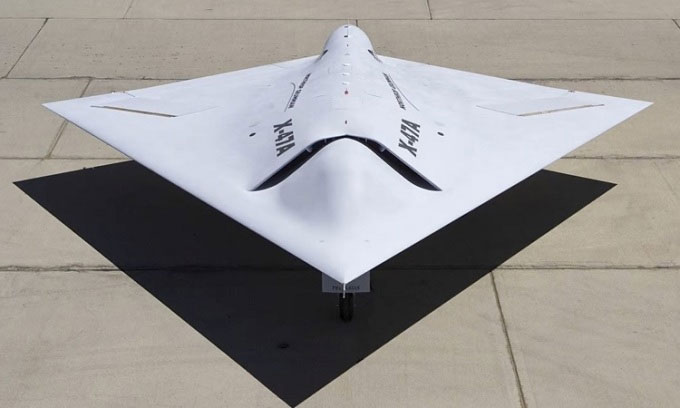China researches supersonic aircraft 5 times faster than the speed of sound
The Chinese team built and tested a prototype of a supersonic engine based on a bold design by a NASA scientist more than two decades ago.
Unlike most belly-powered supersonic aircraft, the Two Stage Vehicle (TSV) X-plane model of Ming Han Tang, a former chief engineer of NASA's supersonic program in the late 1990s, is powered by NASA's supersonic program. two separate engines on either side. The engines can operate like conventional turbojet engines at low speeds and switch to supersonic mode when traveling five times the speed of sound or more.

Boeing Manta X-47C aircraft in the program to test Tang's design. (Photo: SCMP)
The aerodynamics of the dual-engine design are complex, and some important issues such as whether the engine will activate after switching to supersonic speed are not well defined. The US government discontinued the Boeing Manta X-47C, a program intended to test Tang's design, in the early 2000s due to technical and cost constraints. Professor Tan Huijun and colleagues at Nanning University of Aeronautics and Astronautics in China's eastern Jiangsu province, built a prototype of the TSV with a pair of air intakes on either side.
Tan tested the prototype in a wind tunnel that simulated flight conditions from Mach 4 to Mach 8 (4,939 - 9,878 km/h) in seconds. The engines could start in some of the most extreme flight conditions just as Tang predicted. The design is attracting a lot of attention because understanding how it works could provide important clues for the development of supersonic aircraft and engines, according to the report, published Dec. 5 in the Journal. of Propulsion Technology by Tan et al.
Since the late 1980s, Tang has directed NASA's hypersonic flight research program while overseeing collaboration with the US Air Force. Tang left NASA in 1999 and became a consultant. He died in Williamsburg, Virginia, in 2018 at the age of 79. Tang's design was far from perfect, according to Tan et al. Computer simulations and experimental results show that strong turbulence can occur in some corners of the air intake, affecting the balance when flying. The design is also limited to how steep the plane can be moved without clogging the engines. While dual-motor design is feasible with some advantages, there are still many challenging issues to be solved.
According to Yin Zeyong, director of science and technology at China Aviation Engine Corporation in Beijing, the country is developing and testing turbojet engines that can fly at Mach 3 - 4 (3,704 - 4,939 km/h) to combine with or replace missiles on supersonic aircraft. Chinese authorities plan to build an airplane that can carry 10 passengers anywhere on Earth within an hour by 2035.
Despite many challenges such as the risk of overheating and complex construction, a supersonic engine based on turbojet technology is a more viable and optimal choice, Yin said. In July, the US Air Force awarded a $60 million contract to the startup Hermeus to develop a prototype aircraft with similar technology for three years. Hermeus' Quarterhorse aims to reach Mach 5 with one engine.
- NASA develops supersonic passenger aircraft
- NASA is developing an imaginary aircraft, flying faster than the speed of sound
- S-512 supersonic jets fly 1.8 times faster than the speed of sound
- The US is about to launch 20 times faster than sound
- US aircraft make up six times as fast as the speed of sound
- The flight crossed the first sound wall of mankind
- Video: The supersonic plane with the speed of over 2,700km / h is about to be tested
- Dizzy watching American supersonic equipment run at 8 times the speed of sound
- NASA tested noise reduction technology for civil aircraft
- Passenger aircraft fly as fast as five times the speed of sound
- Jump from a height of 39km with supersonic speed
- Passenger double speed test sound
 The US company is about to build a supersonic passenger plane of 6,000km / h
The US company is about to build a supersonic passenger plane of 6,000km / h Japan develops avatar robot as in fiction film
Japan develops avatar robot as in fiction film Australia tested the world's first mango picking robot
Australia tested the world's first mango picking robot America develops technology to separate water from animal waste
America develops technology to separate water from animal waste